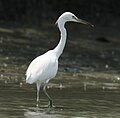| Egretta Temporal range: Late Miocene to present | |
|---|---|
 | |
| White-faced heron, Egretta novaehollandiae | |
| Scientific classification | |
| Kingdom: | Animalia |
| Phylum: | Chordata |
| Class: | Aves |
| Order: | Pelecaniformes |
| Family: | Ardeidae |
| Subfamily: | Ardeinae |
| Genus: | Egretta T. Forster, 1817 |
| Type species | |
| Ardea garzetta [1] Linnaeus, 1766 | |
| Species | |
See text. | |
Egretta is a genus of medium-sized herons, mostly breeding in warmer climates.
Contents
Representatives of this genus are found in most of the world, and the little egret, as well as being widespread throughout much of the Old World, has now started to colonise the Americas.
These are typical egrets in shape, long-necked and long-legged. A few plumage features are shared, although several have plumes in breeding plumage; a number of species are either white in all plumages, have a white morph (e.g. reddish egret), or have a white juvenile plumage (little blue heron).
The breeding habitat of Egretta herons is marshy wetlands in warm regions. They nest in colonies, often with other wading birds, usually on platforms of sticks in trees or shrubs.
These herons feed on insects, fish, and amphibians, caught normally by cautious stalking.
















